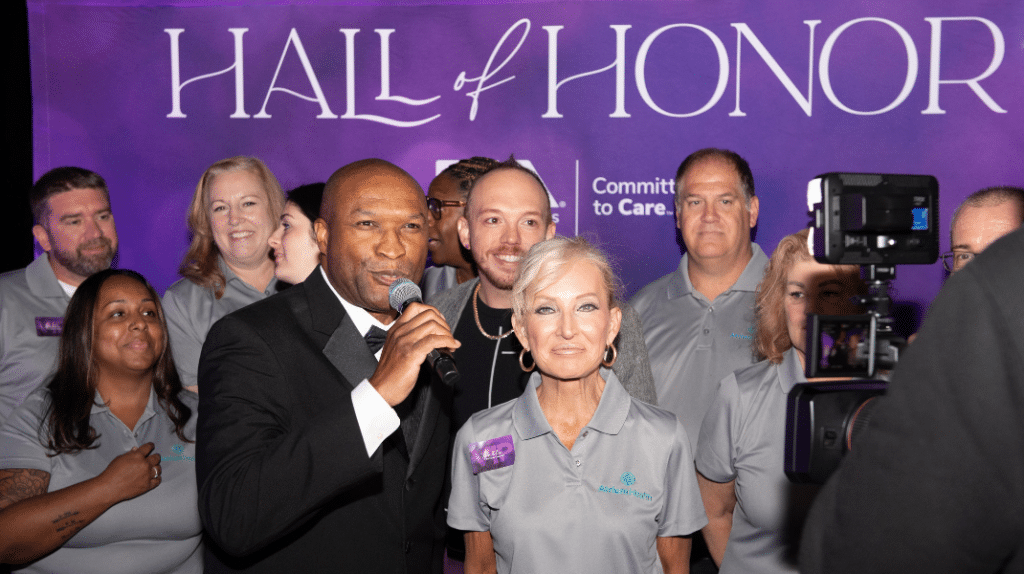The Emergency Nurses Association Utilizes Design Thinking to Reimagine its Awards Ceremony

Like most associations, the Emergency Nurses Association (ENA) has a robust awards and recognition program. These honors include recognition of individuals and teams in various categories.
Award recognition has always been held during the ENA’s annual meeting, but recent efforts felt too quiet for members. A hall of honor was onsite with printed canvases detailing the most prestigious honorees, called Lantern recipients. ENA’s Lantern Award recognizes emergency departments that exemplify exceptional practice and innovative performance in the core areas of leadership, practice, education, advocacy and research.
“We didn’t really hit the mark,” says Denise Wawrzyniak, MA, Senior Director, Branding, Creative Strategy and Events, for the ENA. In fact, a committee member overheard an attendee ask what the point of winning the award was if they couldn’t hear their names called.
“People were disappointed,” says Wawrzyniak, adding, “we put all this energy and time and money into celebrating them, but it didn’t feel like it.”
In addition to attendee feedback, the awards program was growing. Last year, ENA had 53 Lanterns, but this year there were 94. The team knew they needed a program that both recognized the award recipients and could accommodate the program’s growth.

photo credit: Rober Knapp
An Opportunity to Use Design Thinking
Wawrzyniak is a trained designer, so she says that design thinking is how she usually brainstorms. Previously, she’d done bits and pieces of design thinking with the ENA team, but revamping award recognition presented the opportunity for a formal go at the process.
Design thinking, according to Harvard Business School, “is different from other innovation and ideation processes in that it’s solution-based and user-centric rather than problem-based. This means it focuses on the solution to a problem instead of the problem itself.” The process isn’t necessarily new, but the formal system was introduced by Tim Brown, CEO and president of the design company IDEO.
User-centric and solution-based sounds like something tailor made for membership organizations. Wawrzyniak created a problem statement to ground the initial brainstorming. She then broke the process into three sections:
- Divergent: the brainstorming phase where anything is on the table. There are no bad ideas, and everything is captured. “It’s intimidating for some people, especially nurses who are trained that quality is key, not quantity,” says Wawrzyniak.
- Emergent: the team looked for patterns and repetition of ideas to see what would emerge as lasting. This part of the process parsed out ideas like “awardees should get to walk the red carpet.”
- Convergent: this is where ideas become solutions. The red carpet idea turned into a living purple carpet (the brand color of the ENA). A model wore a purple gown with a long train that turned into a purple carpet for attendees to walk—it was special and different and memorable.
ENA Director of Communications Dan Campana suggested turning the closing of the annual meeting into a celebration of award recipients – and the “Ignite the Future Celebration” was born. “We never would have gotten there if we hadn’t gone through all those crazy ideas,” says Wawrzyniak.
The Team & The Process
To capture as many divergent ideas as possible, Wawrzyniak assembled a team from several areas of the organization. There were staff members responsible for administering the Lantern Awards, an HR staffer who specializes in recognition, someone from across the organization who never touches awards, a social media marketer, and a junior designer. The team was intentional in its variety of roles and voices.
The initial brainstorm took four hours. The group started with the divergent part of the process and generated as many ideas as possible. But they also used some of that time to recognize patterns and work on the emergent part of the process.
Wawrzyniak recognizes that, while this example of design thinking was a success, not every program will have the resources to hold a four-hour brainstorming session. She credits her boss, Terrence Sykes, ENA Chief Growth Officer, and department for being supportive of her implementation of design thinking within the ENA.
The Result & Member Feedback

photo credit: Robert Knapp
As mentioned, design thinking focuses on the user and the solution. So how did the ENA’s new awards celebration go? Did they hit the mark this time?
“We did!” Wawrzyniak says. It’s too soon to tally official event evaluations, but she said the anecdotal feedback and general member buzz has been great. “You usually see people just get up and start to leave during the closing,” she says, noting that flights and travel plans often supersede what’s going on at closing ceremonies. “But this year, people hung around and lingered. It was a really good sign.”
Social media was a-buzz after the event with pictures from the living carpet and proud award recipients feeling the afterglow of well-earned recognition.
The ENA created their own buzz around the event as well. “We had Dan in the audience and Terrence on the purple carpet both doing live interviews,” says Wawrzyniak, “that added a lot of energy.”
Next Steps
As with any problem-solving process, the work isn’t finished. Wawrzyniak says the next step is to look at survey results from the event and make sure things resonated the way they expected. Then, the team will keep iterating to further improve the event for award recipients and attendees.
She adds that there may be an opportunity to build out more content from the session. The interviews with attendees helped weave a story into the ceremony, and they’d like to explore more ways to do that.
Finally, she wants to see how they can engage attendees afterwards. The fact that so many people lingered after the event was promising and she sees it as an opportunity.
As for Wawrzyniak, she hopes to do more design thinking with her colleagues at the ENA. She is doing formal training at IDEO University—IDEO being the design group that pioneered the formal system behind design thinking and working towards becoming a Certified Event Designer through the Event Design Collective. It’s safe to say that this is just the beginning for the ENA’s new awards program, and the utilization of design thinking will be integrated into other areas of the organization.
Resources for Design Thinking
If you’re interested in learning more about design thinking and how it can apply to your organization, here are some resources to check out:
- What is Design Thinking? – a blog post from Harvard Business School
- Why is Design Thinking Beneficial? – a blog post from IDEO
- IDEO University – you’ll find courses, a podcast, and more resources
- About the Event Canvas – methodology that applies design thinking to events
Tags
Related Articles
Double Your Footprint: Enhancing Conferences with a Hybrid Event Workflow
By combining on-site engagement with a digital experience, hybrid events can attract diverse audiences, boost...
The Emergency Nurses Association Utilizes Design Thinking to Reimagine its Awards Ceremony
In a prime example of intrapreneurship, the ENA utilized design thinking to innovate within the...
Report Reveals Strategies to Overcome Membership Decline
McKinley Advisors’ Membership Reset report provides a roadmap that association leaders can use to refocus...




